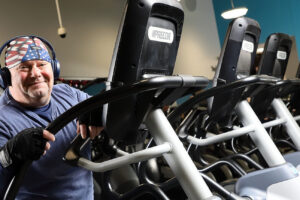Carolanne Weinberger suffered from hip pain for years but wouldn’t let it slow her down. In fact, she ran 21 races in 2019. She soon learned, however, that you can’t outrun hip pain.
Carolanne, 54, works out every day. The Toms River resident started experiencing hip pain three years ago. She tried active release therapy—a type of soft tissue therapy designed to reduce joint stress and muscle pains—before being prescribed anti-inflammatory medication and physical therapy. The pain still increased, but she never stopped working out.
“I was in pain whether I was sitting on the couch or at the gym, so I kept going to the gym,” explains Carolanne, who runs or walks three to five miles daily.
For a year and a half, Carolanne was treated with cortisone shots. The shots provided temporary relief, but the wear and tear caused by frequent running damaged her hip joint, and she began to feel bone-on-bone pain.
“The pain was so bad that I was nearly in tears every day,” says Carolanne, a technology teacher. She then met with orthopedic surgeon Eric Buxbaum, DO, who recommended total hip replacement surgery.
“Carolanne’s X-rays showed severe arthritis that was limiting motion and causing pain in her groin and hip,” Dr. Buxbaum explains.
While she was nervous about having surgery and feared she wouldn’t be able to continue her active lifestyle, Dr. Buxbaum assured Carolanne that she would be back to racing within a few months. To help make this possible, he used a direct anterior approach to hip replacement surgery, a minimally invasive procedure performed through an incision in the front of the leg. It uses a natural opening between the muscles around the hip to reach the hip joint without cutting muscle. Because the incision is about one-third the length used in the classic posterior approach, there is less damage to nearby tissue. This helps reduce pain, speed recovery, and provide greater stability to the hip joint.
Carolanne was walking the same day as her surgery and went home the next. She used a walker for a week before progressing to a cane, and then completed physical therapy before getting back in the gym four weeks later. Less than three months after surgery, Carolanne was elated to finish second in a 5K.
“Hip replacement surgery can be a life-changing procedure for the right patient,” says Dr. Buxbaum.
“I was concerned that I wasn’t going to be the same me after surgery, but I’m better than I’ve ever been,” adds Carolanne.
Learn more about orthopedic services at CentraState at centrastate.com/orthopedics or 866-CENTRA7 (866-236-8727).





